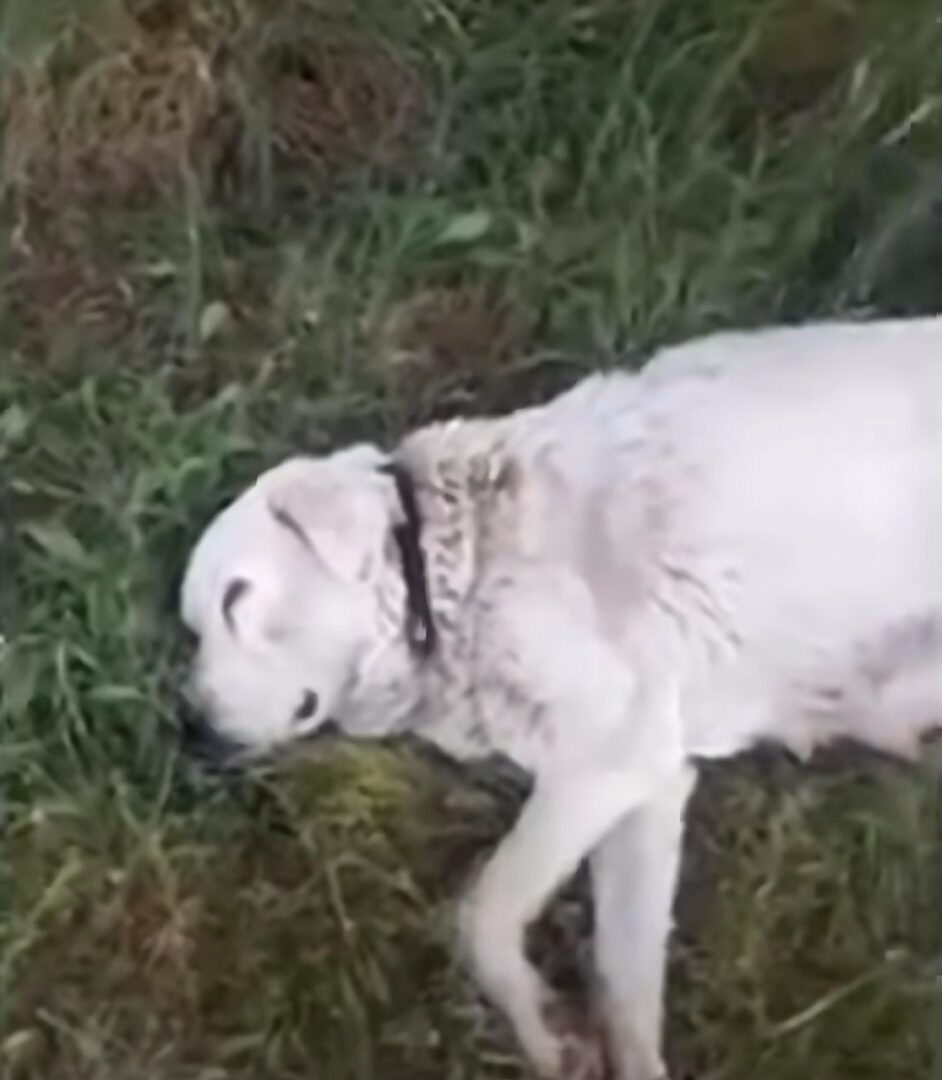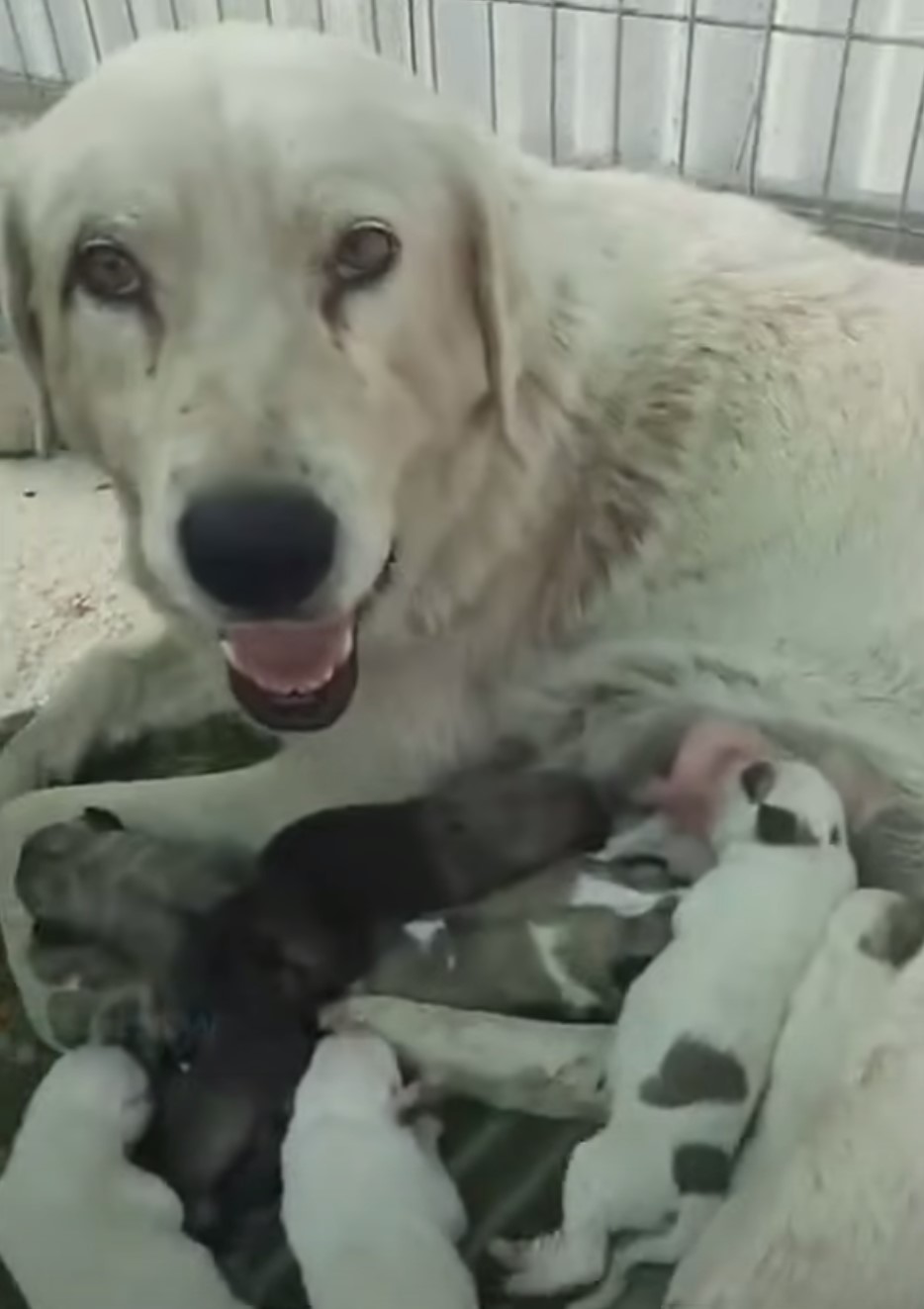Sukha is a soon-to-be mom with a very dark past.
When she became pregnant, Sukha’s owner did not want to take care of so many pups so they abused her, neglected and even starved her.
She spent her days in fear, not knowing what her owner might do to her next and not knowing how she would raise her babies in such conditions. One day, she decided that she would no longer endure such abuse, so she ran away in order to find a safe place to give birth to her litter.
Bravest Mama Ever

Sukha, still having a rope around her neck, ran as far away from her owner as she could. But, being in such a state, she became extremely exhausted and collapsed by the side of the road.
Luckily, a kind hooman found her and, after having a closer look, came to a shocking discovery.
Sukha went into labor!
They quickly got her in their car and rushed her to the vet, where she could be properly taken care of.

When she arrived at the vet, Sukha was still extremely exhausted. But, meeting all the kind people really did make her feel more relaxed.
The vets immediately noticed that her breasts were swollen and milky – a clear indicator that she was about to give birth at any moment!
The veterinary staff stayed by the brave mama’s side and closely monitored her condition. They spoke to her in a calm and soothing voice, reassuring her that she was safe and that nothing would hurt her ever again.

Not long after, Sukha gave birth to a litter of the cutest puppies ever. In the end, she became a mother of twelve pups… incredible!
Everybody at the vet clinic was so proud of this brave mama and made sure to do everything in their power to make her as comfortable as she could be.

Sweetest Little Family
It came as no surprise that Sukha was the sweetest mama ever. She was incredibly gentle with her pups, making sure that they were clean, fed, and warm at all times.
She decided to completely forget about her dark and tragic past and embrace her new role as a mother.

Seeing what an incredible pup she was, Sukha’s rescuers knew that she deserved a second chance at life and they were set on finding her a loving forever home.
For the time being, and until her puppies grow up, this brave mama will stay in the care of her rescuers, where she will receive everything she needs and so much more.
But, I am sure that when the time comes, both she and her puppies will become part of a loving family who will love and adore her, just like she deserves.

Final Word
Unfortunately, Sukha is not the only pup who suffered such horrific abuse.
There are many pups out there who are constantly being mistreated and neglected, and they haven’t done anything wrong!
That is why I would like to take this opportunity to remind you that if you do not have the conditions and means to take care of your dog, please consider surrendering it to your local shelter and offer it a second chance at life.
Also, if you are aware of a dog being mistreated, please contact your local authorities and inform them of the situation – they will handle the rest!
If you’ve noticed your furry companion scratching more than usual or developing patchy hair loss, you might be dealing with a common yet pesky issue – mange. This skin condition can be a real nuisance for dogs and their owners alike, causing discomfort and frustration. Understanding what mange is and how it affects your pup is key to providing the necessary care and treatment to help them feel their best.
Picture this: your dog’s incessant itching and the sight of red, irritated skin can tug at your heartstrings. Mange is often the culprit behind these symptoms, but fret not, with the right knowledge and proactive measures, you can support your canine friend in overcoming this bothersome condition. Stay tuned to learn more about mange, its causes, and how you can effectively manage it to keep your dog happy and healthy.
Understanding Mange in Dogs
Mange in dogs is a skin condition caused by mites, tiny parasites that can lead to discomfort for your furry friend. These mites can either live on the surface of the skin or burrow into the skin layers, causing irritation and inflammation.
Types of Mange
There are two primary types of mange in dogs: Demodectic Mange and Sarcoptic Mange. Demodectic Mange is caused by Demodex mites and is usually not contagious, while Sarcoptic Mange, caused by Sarcoptes scabiei mites, is highly contagious and can spread to other pets or even humans.
Symptoms of Mange
Common symptoms of mange include intense itching, hair loss, redness, and skin irritation. Your dog may experience hair thinning, sores, and scabs due to persistent scratching. If you notice these signs, it’s essential to consult a veterinarian for proper diagnosis and treatment.
Diagnosis and Treatment
Diagnosing mange typically involves a skin scraping to identify the mites or their eggs under a microscope. Treatment may include medicated shampoos, dips, oral medications, or topical ointments to eliminate the mites and alleviate symptoms.
Prevention
Preventing mange involves keeping your dog’s living environment clean, ensuring regular veterinary check-ups, and avoiding contact with infected animals. Maintaining good hygiene practices and a healthy diet can also help boost your dog’s immune system and reduce the risk of mange.
Conclusion
Understanding mange in dogs is crucial for early detection and effective treatment. By recognizing the symptoms, seeking prompt veterinary care, and following preventive measures, you can help your beloved pet stay happy, healthy, and free from the discomfort of mange.
Types of Mange in Dogs
1. Demodectic Mange
Demodectic mange, also known as demodex or red mange, is caused by the Demodex canis mite that naturally lives in a dog’s hair follicles. Normally, these mites do not cause any issues. However, when a dog’s immune system is compromised, it can lead to demodectic mange. This type of mange is not typically contagious between dogs, as it’s often associated with underlying health problems or genetic predisposition.
2. Sarcoptic Mange
Sarcoptic mange, also called scabies, is caused by the Sarcoptes scabiei mite. Unlike demodectic mange, sarcoptic mange is highly contagious, spreading through direct contact with an infected dog. These mites burrow into the skin, causing intense itching, hair loss, and skin irritation. Sarcoptic mange is a serious condition that requires prompt veterinary intervention to prevent its spread to other pets or humans.
Symptoms of Mange in Dogs
Itching: Dogs with mange often exhibit intense itching, which can lead to skin irritation and discomfort for your furry friend.
Hair Loss: One of the noticeable signs of mange is hair loss, as the mites burrow into the skin, causing hair to fall out in patches.
Skin Redness: Infected skin may appear red and inflamed due to the irritation caused by the mites, indicating a possible case of mange.
Crusty Skin: Mange can result in crusty or scaly skin, especially in the affected areas where the mites have been active.
Thinning Coat: As mange progresses, you might notice your dog’s coat becoming thinner and duller, a common symptom of the condition.
Restlessness: Dogs with mange may also become restless or display behavioral changes due to the discomfort caused by the infestation.
Secondary Infections: In severe cases, mange can lead to secondary bacterial infections, further complicating your dog’s health.
Foul Odor: An unpleasant odor emanating from your dog’s skin could be a sign of advanced mange, indicating the need for immediate veterinary attention.
Diagnosing Mange in Dogs
To diagnose mange in dogs properly, a veterinarian will conduct a thorough examination of your furry friend. Here are the key steps involved in diagnosing mange:
- Physical Examination:
- Your vet will examine your dog’s skin for any visible signs of mange, such as redness, crusts, or hair loss.
- Skin Scraping:
- A skin scraping is a common method used to diagnose mange. Your vet will gently scrape off a small sample of your dog’s skin to check for mites under a microscope.
- Fur Analysis:
- Examining your dog’s fur under a microscope can also help identify the presence of mites or their eggs.
- Symptom Evaluation:
- Your vet will consider the symptoms your dog is experiencing, such as itching, skin irritation, or hair loss, to determine the type of mange present.
- Medical History:
- Providing your dog’s medical history, including any past skin conditions or exposure to other animals with mange, can assist in the diagnosis.
- Diagnostic Tests:
- In some cases, additional tests like skin biopsies or blood tests may be necessary to confirm the type of mange and its severity.
- Treatment Plan:
- Once the diagnosis is confirmed, your vet will create a tailored treatment plan based on the type of mange your dog has, ensuring effective care and management.
By following these steps, your veterinarian can accurately diagnose mange in your dog and provide the necessary treatment to help your furry companion recover and thrive.
Treatment Options for Mange in Dogs
When it comes to treating mange in dogs, the approach varies depending on the type and severity of the condition. Your veterinarian will recommend the best course of action to alleviate your furry friend’s discomfort and promote healing. Here are some common treatment options for mange in dogs:
1. Medicated Baths
For mild cases of mange, medicated baths can be effective. These baths are specifically formulated to help kill the mites causing the infection and soothe your dog’s skin. You’ll need to follow your vet’s instructions on how frequently to bathe your dog and for how long.
2. Medications
In more severe cases, your vet may prescribe medications such as oral or topical treatments to combat the mites responsible for mange. These medications can help eliminate the parasites and reduce the itching and irritation associated with the condition.
3. Antiparasitic Medications
Antiparasitic medications are often used to kill the mites causing mange and stop them from reproducing. These medications may come in the form of spot-on treatments, pills, or injections, depending on the severity of the mange.
4. Anti-Inflammatory Medications
To alleviate the itching and inflammation that accompany mange, your vet may recommend anti-inflammatory medications. These medications can help reduce your dog’s discomfort and promote faster healing of the affected skin.
5. Regular Vet Check-ups
Regular check-ups with your veterinarian are essential to monitor your dog’s progress and adjust the treatment plan if necessary. Your vet will assess your dog’s response to treatment and make any changes needed to ensure effective management of the mange.
6. Environmental Management
To prevent reinfestation of mites, it’s crucial to treat your dog’s environment, including bedding, toys, and living areas. Your vet may provide guidance on how to effectively clean and disinfect these areas to eliminate any remaining mites.
Having a tailored treatment plan based on your dog’s condition is key to successfully managing mange. By following your vet’s recommendations and being diligent with treatment, you can help your furry companion recover from mange and enjoy a happy, healthy life.
Prevention and Care Tips for Mange in Dogs
When it comes to preventing and caring for mange in dogs, a few key tips can make a significant difference in managing this condition effectively. Here are some practical steps you can take to help your furry friend stay healthy and happy:
Regular Vet Check-Ups
Regular visits to the vet are essential for monitoring your dog’s overall health and catching any potential issues, including mange, early on. Your veterinarian can provide guidance on preventive measures and treatment options tailored to your pet’s specific needs.
Environmental Management
Maintaining a clean living environment for your dog is crucial in preventing mange and reducing the risk of reinfestation. Regularly clean and disinfect your pet’s bedding, toys, and living spaces to minimize the presence of mites that cause mange.
Healthy Nutrition
A balanced diet plays a vital role in supporting your dog’s immune system and overall well-being. Providing your pet with high-quality food rich in essential nutrients can help boost their immune response and improve their ability to fight off infections, including mange.
Avoid Contact with Infected Animals
Limiting your dog’s exposure to other animals known to have mange can help reduce the likelihood of transmission. Be cautious when socializing your pet and avoid interactions with animals showing signs of skin problems until they receive proper treatment.
Regular Grooming
Regular grooming sessions not only keep your dog looking neat but also allow you to inspect their skin and coat for any signs of mange or other skin conditions. Brushing your dog’s fur regularly can help prevent matting and promote healthy skin.
Administer Medications as Directed
If your veterinarian prescribes medications to treat mange, ensure you follow their instructions carefully. Administer medications, whether oral or topical, as directed, and complete the full course of treatment to maximize effectiveness and prevent recurrence.
By following these prevention and care tips for mange in dogs, you can help your furry companion stay healthy, happy, and mange-free. Remember, early detection and proactive management are key to ensuring your pet’s well-being.
Conclusion
That’s a wrap on understanding mange in dogs! Remember, early detection and proactive care are key to keeping your furry friend healthy. By following prevention tips like regular vet visits, maintaining a clean environment, and providing proper nutrition, you can help safeguard your dog against mange. Stay vigilant, show them love, and you’ll both enjoy a happy, itch-free life together.
Frequently Asked Questions
What are the types of mange in dogs discussed in the article?
The article covers Demodectic and Sarcoptic mange, detailing their causes, symptoms, and treatment options.
How can mange in dogs be diagnosed?
Mange in dogs can be diagnosed through skin scrapings, skin biopsies, or blood tests to identify the specific type of mite causing the infection.
What are the treatment options for managing mange in dogs?
Treatment for mange in dogs may include medicated baths, oral medications, spot-on treatments, and addressing any underlying health issues contributing to the mange infection.
What prevention and care tips are recommended for mange in dogs?
Prevention and care tips include regular vet check-ups, maintaining a clean environment, feeding a balanced diet, avoiding contact with infected animals, routine grooming, and ensuring proper administration of prescribed medications.
[no_toc]

Hey there, I’m Janet Brooks, a dog-loving student from California. I’m all about helping pups in need, especially those without homes. Me and my awesome friends work together to give shelter and love to stray dogs. Oh, and I also write blogs about dogs to share helpful info.